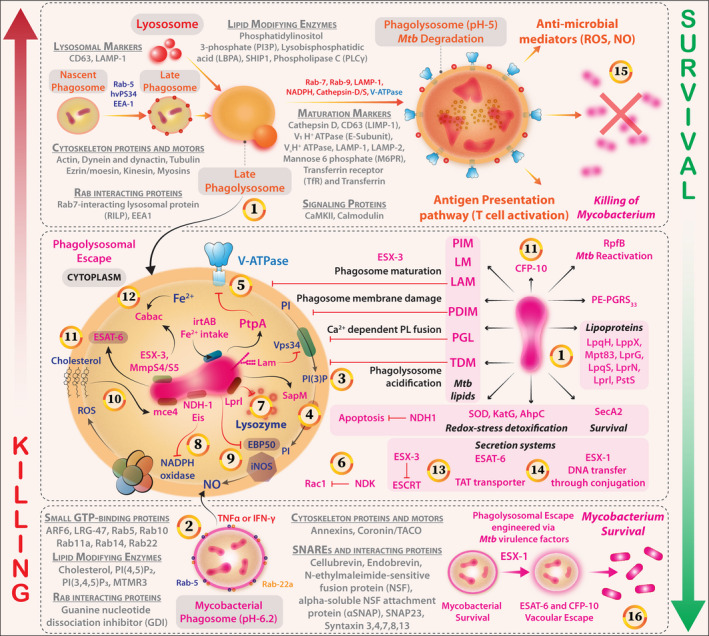Figure 5.

Pathway of phagosome biogenesis, maturation, and phagolysosome fusion for efficient clearance of Mtb. Ploys of immunoevasion via Mtb virulence factors are also shown. (1) Mycobacterium deploys several factors that subvert the phagosome biogenesis, maturation and acidification steps that follow its internalisation. Pathogenic Mycobacteria reside within compartments devoid of lysosomal contents because of blocking of Ca2+ fluxes and receive nutrients through modulation of Rab‐dependent vesicular trafficking. LAM and PIM drive these processes. (2) Mycobacterial phagosomes (Bottom) through various proteins counter the independent stress factors such as reactive oxygen species (ROS) and reactive nitrogen species (RNS); however, immunological activation with TNFα or IFN‐γ results in the maturation of phagosomes by the maturation marker expression and lysosomal fusion (Their distinct markers and associated proteins are represented with Grey Font). (3) LAM inhibits Ca2+ influx and PI3P‐dependent delivery of lysosomal components (V‐ATPase and Cathepsin) from the Trans‐Golgi network (TGN) to the phagosome. (4) Mycobacterium, perhaps through secretory acid phosphatase (SapM), targets small GTPases – Rabs, Rhos or ARFs – to affect Coronin‐1/TACO‐dependent actin cytoskeleton rearrangements and phagosome maturation. (5) The mycobacterial protein tyrosine phosphatase (PtpA) inhibits V‐ATPase and phagosomal acidification. (6) The nucleotide diphosphate kinase (NDK‐1) of mycobacterium may inactivate small GTPase Rac‐1 and attenuate NADPH oxidase‐mediated host protection. (7) Lprl, a mycobacterial Lipoprotein, inactivates the lysozyme. (8) The Type‐I NADH dehydrogenase and Eis protein inhibit the NADPH oxidase activity limiting the ROS availability. (9) Mycobacterium effectively attenuates NO production by interfering with EBP50 and iNOS recruitment. (10) The mammalian cell entry protein‐Mce4 scavenges cholesterol from host membranes and potentiates lipid body accumulation and mycobacterial survival. (11) Early secretory antigenic target‐6 (ESAT‐6), a major virulence factor that controls NF‐κB and interferon‐regulatory factors, and CFP‐10 engineer vacuolar escape and intracellular survival of Mycobacterium. (12) Mtb hitchhikes intracellular Fe2+ stores a major siderophore mediating this process is Carboxymycobactin. (13) ESX‐3 secretion system (composed of EsxG and EsxH) leads to impairment of ESCRT‐mediated endomembrane repair. (14) ESX‐1 mediates the process of phagosomal to cytosolic translocation. (15) A potent phagosomal maturation and intracellular degradation of Mtb by the acquisition of indicated markers (Grey fonts). Results in potentiation of APC‐T‐cell antigenic presentation pathway and confers T cell‐based protection against the bacterium. (16) In contrast, the association between Mtb virulence factors (Factors that are associated with Mtb are shown in pink colour) and potent immunosuppression, steps of phagosomal, maturation, acidification, neutralisation/detoxification of redox stress and inhibition of autophagic processes together induce permissive niches for Mtb replication and dissemination.
